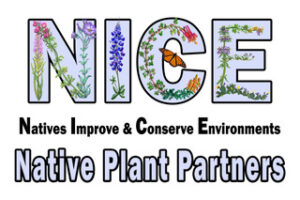Look for this logo at participating nurseries:

The following nurseries participate in NPSOT’s NICE (Natives Improve and Conserve Environments) program. They receive support from their local NPSOT chapter, and have demonstrated an effort to stock native plants. Check the NPSOT website – www.npsot.org – under Resources to find additional nurseries across the state.
Archie’s Gardenland, 6700 Camp Bowie Boulevard, Fort Worth, 76116, 817-737-6614
www.archiesgardenland.com/
D&L Farm and Home, 7976 Highway 377, Pilot Point, TX 76258, 940-365-3129
www.dandlfarmandhome.com
The Denton Plant Factory, 1421 North Loop 288, Denton, TX 76209, 940-514-1234
www.DentonPlantFactory.com
Eco-blossom Nursery, on-line only, local delivery, 817-720-5970
www.ecoblossom.com
Hartwell’s Nursery, 1570 N. Stemmons, Lewisville, TX 75067, 972-436-3612
www.hartwellsnursery.com
Marshall Grain, 5311 Colleyville Blvd, Colleyville, TX 76034 , 817-416-6600,
www.marshallgrain.com
Meador’s Nursery, 2623 James St, Denton, TX 76205, 940-382-2638,
www.meadornursery.com
Native Roots Perennial Farm & Garden, 8463 Crestview Rd, Sanger, TX 76266, 940-395-0886,
By Appointment Only
https://www.facebook.com/profile.php?id=100090967043688
North Haven Gardens, 7700 North Haven Road, Dallas, TX 75230
214-363-5316,
www.nhg.com
Painted Flower Farm, 3801 Lariat Rd, Denton, TX 76207, 940-382-3789,
www.paintedflowerfarm.com/
Queen Bee’s Nursery, 200 E. Main St., Azle, TX 76020, 817-444-2400
www.azletexasflowershop.com/
Redenta’s, 2001 Skillman, Dallas, TX 75206, 214-823-9421
www.redentas.com/
RootedIn, 12804 Pelzel Road, Pilot Point, TX 76258, 979-777-4522
http://www.rootedin.com/%20
Shades of Green, 8801 Coit Road, Frisco, TX 75035, 972-335-9095,
www.shadesofgreeninc.com/
Shades of Green Nursery & Landscape Celina, 1213 Sunset Blvd
Celina, TX 75009, 972-335-9095, https://shadesofgreeninc.com/
Weston Gardens in Bloom, 8101 Anglin, Fort Worth TX 76140, 817-572-0549,
www.westongardens.com


